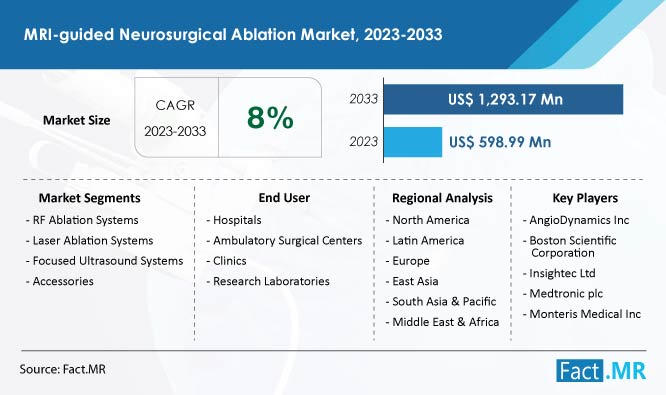Advancements in medical technology are continually reshaping the landscape of healthcare, offering innovative solutions for complex medical procedures. One such remarkable innovation is the MRI-guided neurosurgical ablation, a cutting-edge technique that combines the power of magnetic resonance imaging (MRI) with precise neurosurgical procedures.
Download Sample Copy of This Report:
https://www.factmr.com/connectus/sample?flag=S&rep_id=8318?AS
The Power of MRI-guided Neurosurgical Ablation
MRI-guided neurosurgical ablation involves the use of real-time MRI imaging to guide and monitor neurosurgical procedures, particularly those involving the targeted ablation (destruction) of specific brain structures or tumors. This fusion of imaging and surgical precision enables healthcare professionals to precisely navigate the intricate landscape of the brain, enhancing both diagnostic accuracy and treatment efficacy.
Applications and Benefits
- Tumor Ablation: MRI-guided ablation offers a minimally invasive approach for treating brain tumors. By precisely targeting and destroying abnormal tissue, it helps reduce the risk of damage to healthy surrounding tissue.
- Epilepsy Treatment: For patients with epilepsy that doesn’t respond to medication, ablation procedures can target the seizure focus, potentially reducing or eliminating seizures.
- Pain Management: Chronic pain conditions that are challenging to manage with medications can be targeted using ablation techniques, providing relief to patients.
- Functional Neurosurgery: This technique aids in the treatment of movement disorders like essential tremor or Parkinson’s disease, by selectively ablating brain regions responsible for abnormal movements.
- Less Invasive Procedures: Traditional open surgeries are associated with longer recovery times and higher risks. MRI-guided ablation offers a less invasive alternative, often resulting in shorter hospital stays and faster recovery.
Challenges and Innovations
- Precise Navigation: Ensuring accuracy and precision in real-time MRI-guided procedures requires advanced imaging techniques and specialized equipment.
- Real-time Monitoring: Constant monitoring of the ablation process within the MRI scanner presents technical challenges, but innovations in imaging and software are addressing these concerns.
- Patient Safety: Managing patient safety in the MRI environment during surgery requires careful attention to factors like anesthesia, monitoring, and metal compatibility.
- Expertise and Training: Neurosurgeons and medical professionals require specialized training to effectively use and interpret real-time MRI guidance.
Future Trends
- Enhanced Imaging: Ongoing improvements in MRI technology will offer even higher resolution and more detailed real-time images, further enhancing the precision of procedures.
- Expanding Applications: As the technology matures, MRI-guided ablation could find applications in treating a broader range of neurological conditions.
- Minimally Invasive Focus: The trend towards less invasive procedures will likely continue, reducing patient trauma and recovery times.
- Integration with Robotics and AI: The integration of robotics and AI could further refine the precision and safety of MRI-guided ablation procedures.
Conclusion
The MRI-guided neurosurgical ablation industry represents a remarkable fusion of imaging technology and surgical precision. By allowing healthcare professionals to navigate the complex realm of the brain with unprecedented accuracy, this innovation is transforming the way we approach neurosurgical procedures. As the industry continues to advance and embrace new technologies, the future holds the promise of even more refined procedures, improved patient outcomes, and a brighter landscape for neurosurgical interventions.
